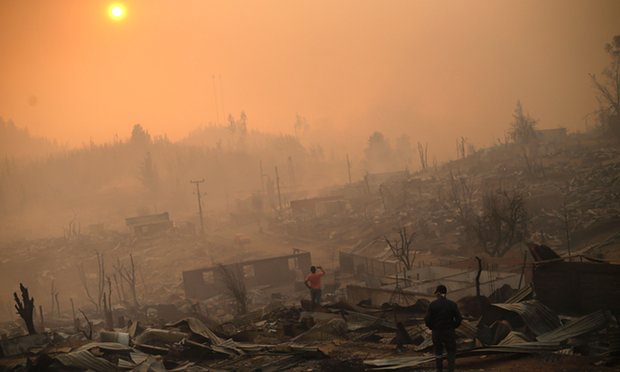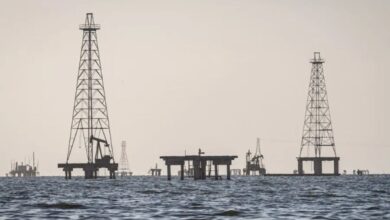Chile wildfires leave smouldering tensions over role of forestry industry


The smoke has almost cleared, the blazes that raged over half a million hectares of forests, bush and grassland mostly extinguished, but the air is still thick with recriminations against Chile’s eucalyptus and pine plantation owners who are accused of putting profits before safety.
Following the worst fires in the country’s history, activists are asking whether the unregulated expansion of the forestry industry under the dictator Augusto Pinochet will lead to more problems in a future that is likely to be hotter and drier as a result of climate change.
Eleven people were killed and close to 1,600 dwellings were lost to the fires which erupted in January, along with hundreds of thousands of hectares of forest and farmland.
Fire chiefs said that multiple factors caused the blazes, but environmentalists say the toll was higher than it should have been because plantations had expanded to the edge of communities and companies had failed to insert firebreaks.
“We’ve been warning the forestry sector for the last eight years about the growing threats; and these plantations are never subjected to environmental risk assessments – they’re completely unregulated,” said Sara Larraín, former presidential candidate and director of the environmental NGO Chile Sustentable.
The US Forest Service deems eucalyptus plantations “highly flammable” and recommends that they should always be separated from human settlements by firebreaks. With respect to Monterey pine – the most common species planted in Chile – the same body states that “fire is a particular hazard to young, thin-barked trees and can be disastrous in dense plantations where persistent lower limbs become festooned with dead needles, resulting in an ideal situation for crowning fires.”
In Chile, however, many plantations border villages, towns and even cities.
And this summer’s fires are not the first time that such proximity has caused problems. A devastating 2014 fire in Valparaíso – which destroyed 2,400 homes and killed 15 people – began on a farm and spread through a eucalyptus plantation to the outer suburbs of the city.
Activists say that the seeds of the problem were sown decades ago, when Chile’s forestry industry was established in the early years of the Pinochet dictatorship. A 1974 government decree subsidised 70% of plantation costs, and over the next 40 years – and after the return to democracy – the sector received around $ 800m in taxpayers’ money. Three-quarters of the cash went to the two companies that dominate the industry: Arauco and CMPC.
Arauco’s senior vice-president, Charles Kimber, said the industry had been unfairly demonised despite its important role in rebuilding Chile after what he called “communist-socialist regime, dictatorship” – a reference to the democratically elected Salvador Allende government overthrown by a military coup in 1973.
When asked why plantations weren’t adequately separated from urban sectors, Kimber said: “Undoubtedly there needs to be a much better effort regarding interurban zones, by government, by municipalities, by companies, by individual forest owners.”
Managed by two of Chile’s richest industrialist families, Arauco and Forestal Mininco-CMPC enjoy combined annual sales of over $10bn, much of it from pulp and timber sales to the US.
The general manager of Forestal Mininco, Eduardo Hernández, told local media that “according to Chilean law as administered by the Forestry Commission-Conaf, plantation companies only need to present a management plan for the prevention and control of fires, with no specifications required for including firebreaks.”
The sector as a whole contributes 2.6% to the country’s GDP and employs about 300,000 workers (5% of Chile’s labour force).
However, many critics in Chile argue that the huge wealth generated by the plantations doesn’t truly benefit the regions where they are located, two of which, Maule and La Araucanía, have some of Chile’s highest levels of poverty and unemployment.
Santa Olga, a village that was razed to the ground in January, illustrates this disparity: of its 1,500 homes, only 350 had a direct potable water supply and were connected to a sewage system, the other houses using a cesspit and asking their neighbours for water. Electric power was directly supplied to less than half of the homes.
The big companies claim that 90% of plantations were planted on degraded land, but environmentalists and local inhabitants disagree.
Santa Olga’s fire chief, Carlos Hernández, lost his home, fire station and the sawmill where he worked in January’s “mega blaze”. Now aged 33, he recalls how his home region, including the city of Constitución, was surrounded by vast native forests of Roble beech.
“We’d collect digueñes fungus from the trees and use them in a nice little salad; and people would gather forest mushrooms, to eat and sell to a local tomato sauce manufacturer – but those woods have all disappeared now.”
The fate of the native forests: wood chips for export.
Dr Mary Kalin-Arroyo, biologist and director of the Institute of Ecology and Biodiversity at the University of Chile, said that people should be encouraged to move away from the plantations and IGNORE INTO better-planned, greener and more spacious small towns and cities.
Rural land, she argued, should be divided between industrial forests, other areas allowed to recover their native vegetation, and the remaining native forests.
Kalin-Arroyo said that due to global warming, all of Chile’s forests are at a greater risk. “We’re going to have to live with the increased occurrence of forest fires,” she said.





